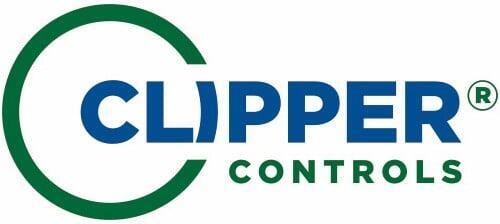
Equipment Shelters
Clipper Controls offers a complete line of pre-engineered and fully customizable fiberglass equipment shelters and enclosures designed to safeguard instrumentation, controls, and mechanical systems across a wide range of industrial and municipal applications. Whether you need a single-piece shelter for remote flow metering or a modular, fully customized building for complex analyzer systems, our fiberglass solutions provide superior strength, weather resistance, and design flexibility. From compact enclosures for field instruments to walk-in shelters with HVAC, lighting, and safety systems, we help protect your infrastructure where it matters most.
Available Customizations
Size: Shelters and enclosures can be tailored in width, depth, and height to fit specific site and equipment requirements.
Doors: Choose from single, double, roll-up, or custom-sized doors to accommodate equipment access and personnel entry.
Electrical: Integrated electrical options include outlets, switches, and conduit types such as PVC, EMT, or rigid steel.
HVAC: Configure shelters with heating, ventilation, and cooling systems—available in powered, unpowered, or solar options.
Floors and Bases: Select from reinforced floors, grated bases, or chemical-resistant liners depending on the application.
Lighting: Interior and exterior lighting can be added, including standard fixtures, motion sensors, and skylights for natural light.
Access Panels / Bulkheads: Custom access points and partitioned bulkheads allow for safe cable routing and equipment service.
Safety Equipment: Optional safety features include warning horns, beacon lights, and emergency showers or eyewash stations.
Modular & Single Piece Shelters
Built to withstand demanding environments, our walk-in fiberglass buildings and shelters are engineered for performance, durability, and adaptability. Available in single-piece or modular configurations, these shelters can be customized to meet site-specific requirements. With countless options for doors, electrical layouts, HVAC systems, and safety features, Clipper Controls shelters offer reliable protection and ease of integration for critical field operations.
Single Piece Shelters:
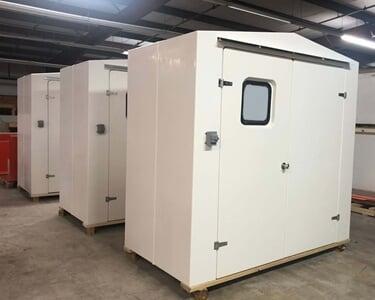
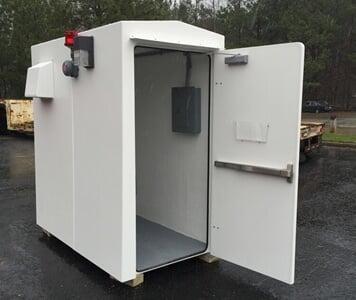
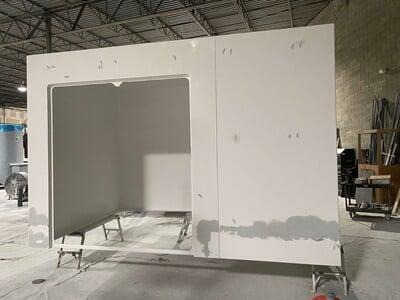
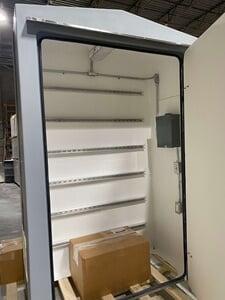
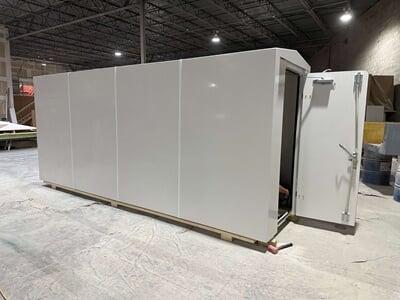
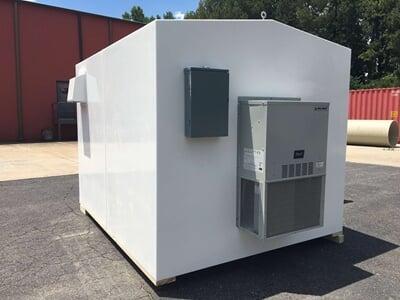
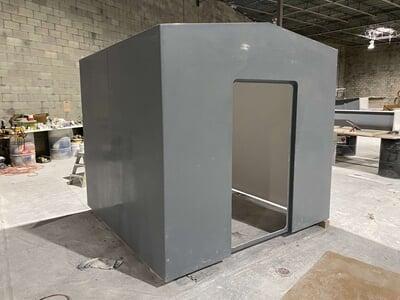
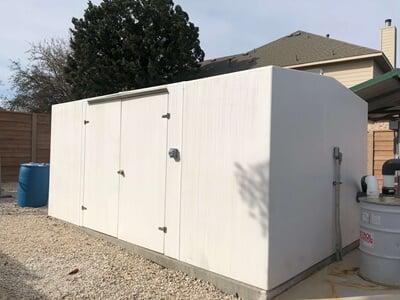
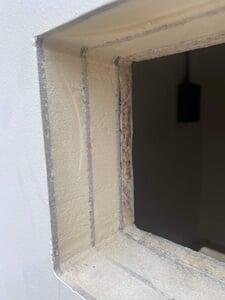
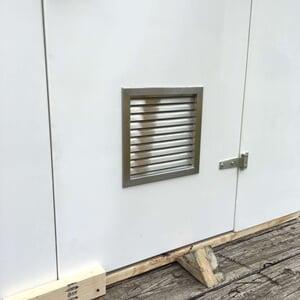
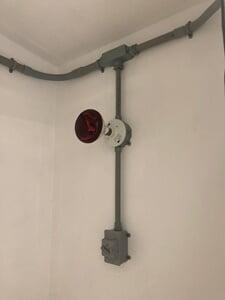

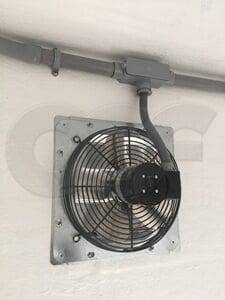
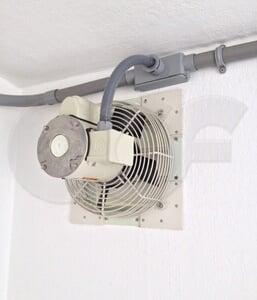
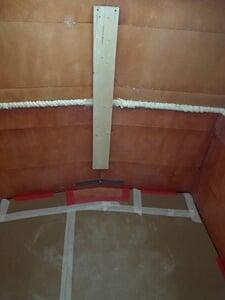
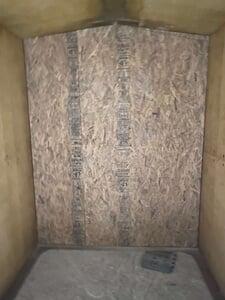
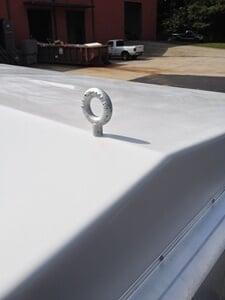
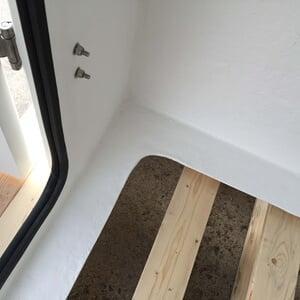
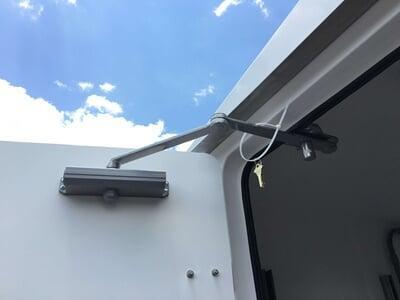
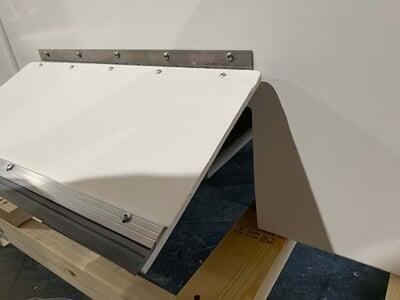
Modular Shelters:
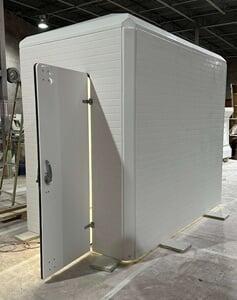
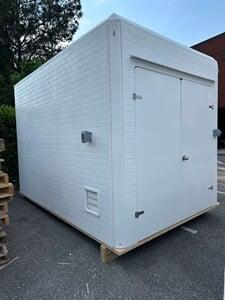
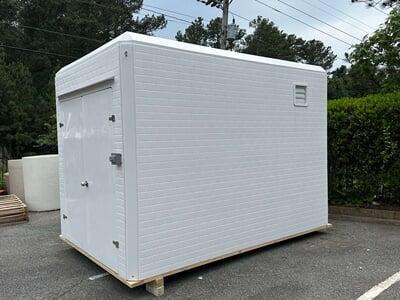
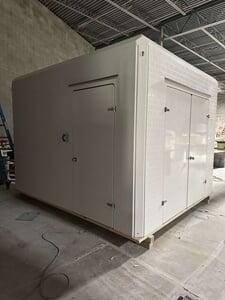
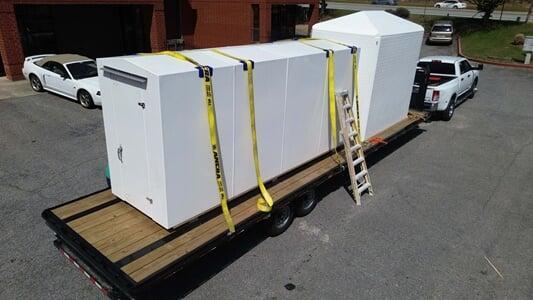
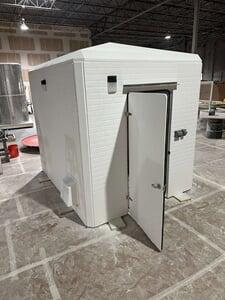
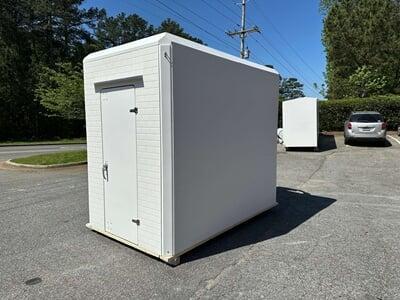
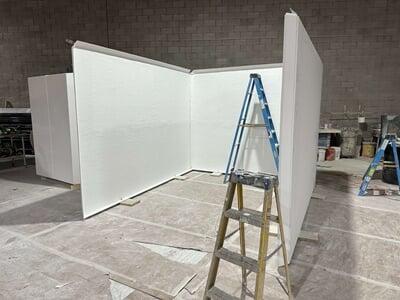

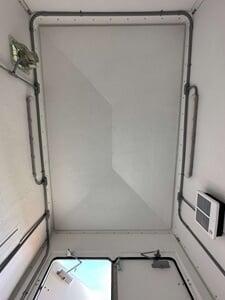
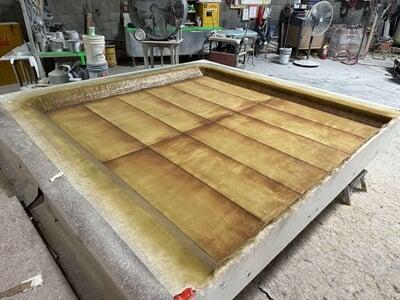
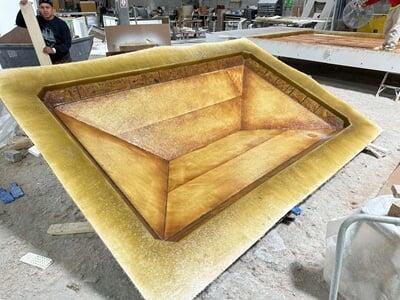
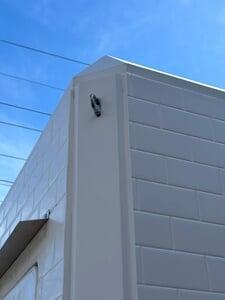
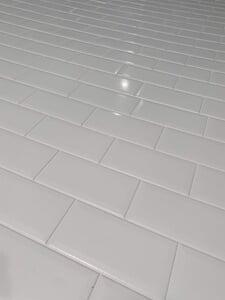
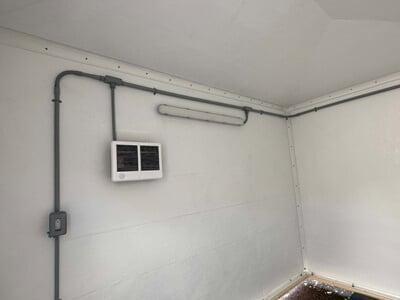
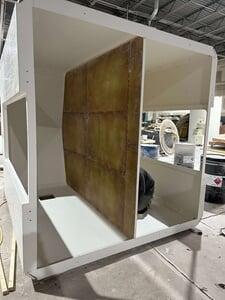
Equipment Enclosures
Clipper Controls offers a range of durable, equipment enclosures designed to protect instruments and control devices in demanding environments. These fiberglass enclosures are ideal for housing flow meters, samplers, and a wide range of electrical and mechanical equipment—providing secure, weather-resistant protection in compact footprints. Available in standard sizes or custom configurations, our enclosures support reliable performance and long-term field operation across a wide range of industrial and municipal applications.
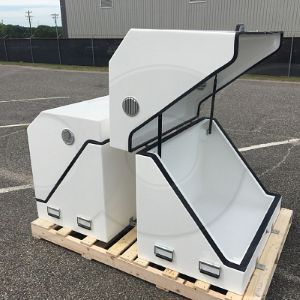
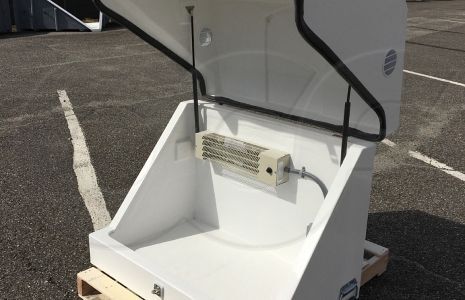
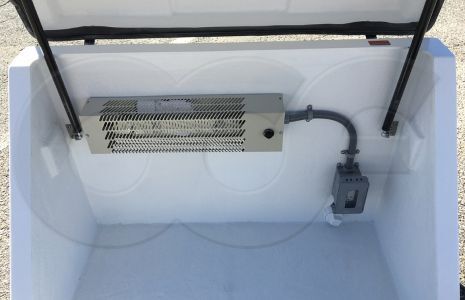
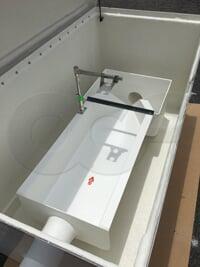

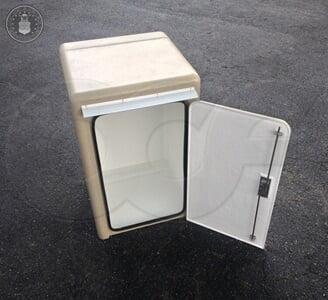
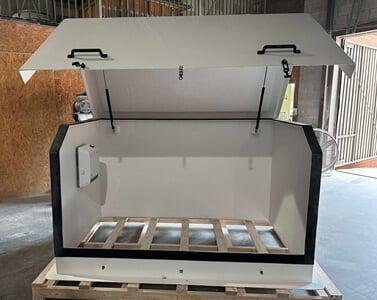
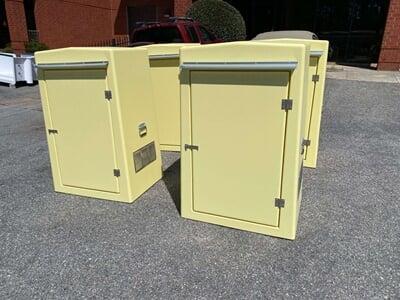
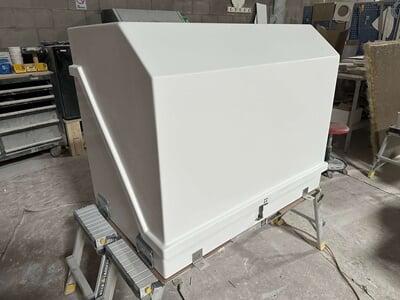
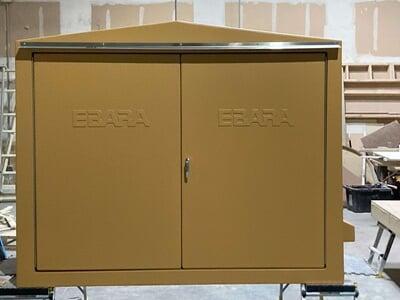
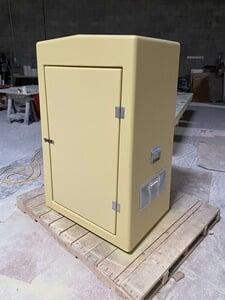
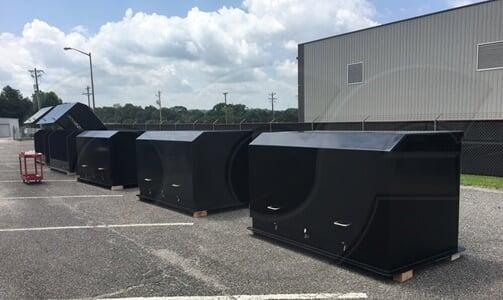
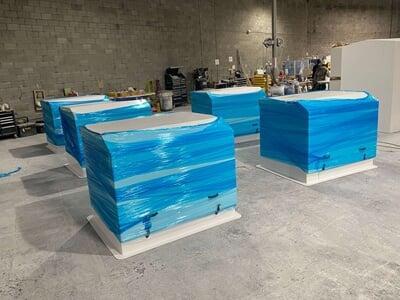
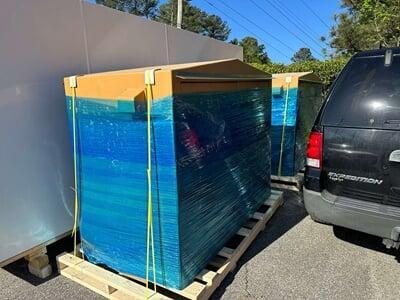
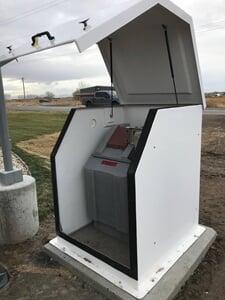
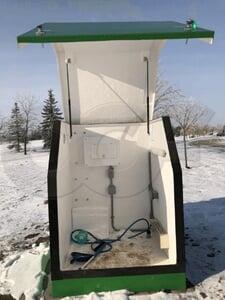
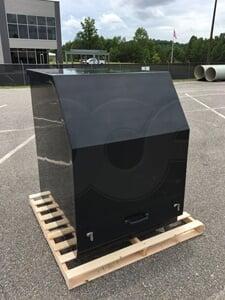
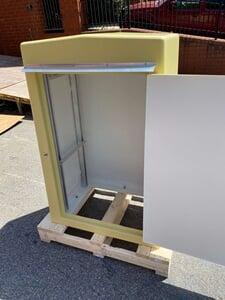
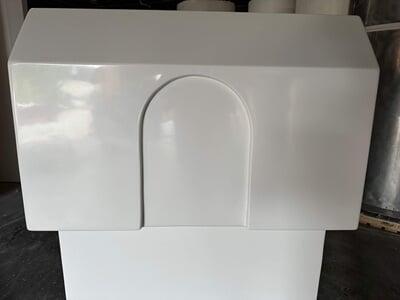
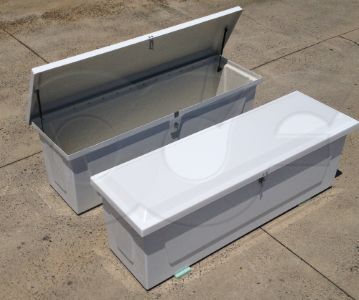
Talk to an Expert
Need Help?
Our Crew is Here To Serve You!
Modular & Single Piece Shelter Applications
Analyzer Shelters - CEMS Shelters (Continuous Emissions Monitoring)
CEMS shelters are engineered to house Continuous Emissions Monitoring Systems, which are used to measure pollutant concentrations in exhaust gases from industrial stacks, boilers, turbines, or incinerators. These systems are critical for complying with environmental regulations such as EPA 40 CFR Part 60 and 75, requiring precise monitoring of gases like NOx, SO₂, CO, CO₂, and O₂.
To ensure measurement accuracy and equipment longevity, CEMS analyzers must be housed in tightly controlled environments. Shelters are equipped with HVAC systems, insulation, and vapor barriers to maintain stable temperature and humidity levels, minimizing drift and condensation that could damage sensitive optics or electronics. They may also include gas cylinder storage, calibration systems, and sample conditioning components integrated into a single, pre-wired, factory-tested structure.
These shelters are commonly installed at power plants, refineries, cement kilns, and chemical manufacturing facilities—anywhere emissions monitoring is required for regulatory compliance or environmental reporting. Designed for harsh outdoor conditions, they also provide physical security, protection from weather extremes, and organized cable routing for seamless integration into plant systems.
Chemical Feed
Chemical feed shelters are designed to house dosing systems that deliver precise amounts of chemicals into water, wastewater, or industrial process streams. These shelters provide a controlled environment for metering pumps, tanks, piping, and monitoring equipment used in applications such as disinfection, pH control, corrosion inhibition, scale prevention, and nutrient removal.
By enclosing the chemical feed system, these shelters protect critical components from weather, temperature extremes, and unauthorized access while containing any potential leaks or spills. Fiberglass construction offers excellent corrosion resistance against aggressive chemicals like chlorine, sodium bisulfite, alum, and caustic soda—helping maintain system integrity and reduce maintenance.
Chemical feed shelters are commonly deployed in municipal water and wastewater treatment plants, industrial process facilities, irrigation systems, and environmental remediation projects. Many include safety features such as secondary containment, exhaust ventilation, lighting, and emergency eyewash stations to comply with chemical handling regulations and improve operator safety.
Chlorination/De-Chlorination
Chlorination and de-chlorination shelters are purpose-built to house equipment used in the dosing of chlorine-based chemicals and neutralizing agents for water treatment applications. These shelters typically contain gas cylinders, chemical feed pumps, manifolds, analyzers, and safety systems used to add or remove chlorine in municipal water, wastewater effluent, or industrial discharge streams.
The highly corrosive nature of chlorine and de-chlorination chemicals such as sodium bisulfite or sulfur dioxide requires enclosures made from non-reactive, corrosion-resistant materials—most commonly fiberglass. These shelters are ventilated and often equipped with gas detection systems, emergency shutoffs, and eyewash stations to enhance operator safety and comply with chemical handling regulations.
Common applications include disinfection in drinking water plants, effluent treatment in wastewater facilities, and de-chlorination prior to environmental discharge. The shelters provide weather protection, temperature control, and secure containment for both chemical systems and personnel, ensuring accurate dosing and regulatory compliance in harsh or remote environments.
Flow Metering & Sampling
Flow metering and sampling shelters are engineered to protect critical instrumentation used for monitoring flow rates and collecting representative samples from water, wastewater, and industrial process streams. These shelters typically house flow meters, samplers, controllers, and associated electrical or communication equipment, keeping them secure, climate-stable, and accessible for maintenance.
Applications range from regulatory flow reporting and stormwater monitoring to influent/effluent sampling at treatment plants or industrial facilities. Equipment inside may include automatic water samplers, area-velocity meters, ultrasonic or magnetic flow meters, and refrigerated or composite sampling systems—all of which require protection from temperature extremes, flooding, and vandalism.
Fiberglass construction provides corrosion resistance in humid or chemical-rich environments, while optional HVAC, lighting, and bulkhead entries support year-round performance and safe operator access. These shelters are critical for ensuring data accuracy and equipment uptime in compliance-driven monitoring programs such as NPDES permitting or process optimization initiatives.
Instrumentation / SCADA
Instrumentation and SCADA shelters provide a secure, climate-controlled environment for housing sensitive electronics, control panels, PLCs, RTUs, and communication systems that form the backbone of automation and remote monitoring networks. These shelters support real-time data acquisition, control logic execution, and system communication for process control, utility management, and infrastructure monitoring.
SCADA (Supervisory Control and Data Acquisition) systems often operate in remote or unmanned locations—such as pump stations, lift stations, treatment plants, or energy substations—where exposure to heat, cold, moisture, and vandalism can compromise uptime and data integrity. Shelters ensure stable environmental conditions through insulation, HVAC, and filtered ventilation, while also protecting against dust, rodents, and unauthorized access.
These enclosures are typically constructed from fiberglass for durability and corrosion resistance, with internal raceways, racking, and mounting options for modular equipment layout. Whether managing a single flow controller or an entire plant network, instrumentation/SCADA shelters help ensure uninterrupted operation, regulatory compliance, and streamlined system maintenance.
Polymer Feed
Polymer feed shelters are designed to house systems that prepare and dose polymer solutions used in solid-liquid separation processes such as sludge thickening, dewatering, and flocculation. These shelters protect delicate feed systems—including make-down units, mixers, dosing pumps, and control panels—from environmental damage, temperature fluctuations, and chemical exposure.
Polymers are often delivered in concentrated form and must be accurately blended and injected into process streams to optimize performance and avoid overdosing. Maintaining proper temperature and humidity inside the shelter is critical to ensure solution stability, pump reliability, and overall system accuracy. Enclosures also help prevent polymer spills and contain cleanup within a controlled environment.
Commonly used in wastewater treatment plants, industrial clarifiers, and mining operations, these shelters improve operator safety, reduce maintenance demands, and ensure consistent polymer performance. Constructed with corrosion-resistant materials and available with optional secondary containment, lighting, and ventilation, polymer feed shelters support reliable dosing in both permanent and remote installations.
Pump Stations / Headworks
Pump station and headworks shelters provide vital environmental protection for critical infrastructure at the front end of water and wastewater treatment systems. These shelters typically house pumps, valves, control panels, flow meters, level sensors, and trash removal systems that manage influent flow and debris before it enters downstream processes.
Headworks equipment is exposed to harsh conditions, including high humidity, corrosive gases like hydrogen sulfide, and temperature extremes. Enclosing this equipment in a fiberglass shelter helps mitigate corrosion, extend equipment life, and maintain operator safety. These shelters also reduce odor release, contain noise from pumping systems, and provide safe access for routine maintenance and emergency intervention.
Applications include municipal and industrial wastewater treatment plants, lift stations, and stormwater control systems. With customizable access doors, ventilation systems, and structural reinforcements, pump station/headworks shelters ensure compliance with environmental and safety standards while maintaining reliable operation under demanding conditions.
MCC (Motor Control Center)
MCC shelters are built to protect Motor Control Centers—centralized systems that house motor starters, variable frequency drives (VFDs), circuit breakers, and control equipment for managing pumps, blowers, mixers, and other motor-driven processes. These shelters provide a controlled environment essential for electrical safety, operational uptime, and ease of maintenance.
Often deployed at water and wastewater plants, industrial facilities, and remote pumping stations, MCC shelters safeguard against moisture, dust, temperature swings, and corrosive atmospheres that can degrade electrical components and cause costly failures. Fiberglass construction offers superior corrosion resistance, and integrated HVAC systems maintain temperature and humidity levels to protect sensitive drives and control logic.
Designed for walk-in access, these shelters support organized cable routing, service accessibility, and compliance with NEC and NFPA electrical codes. MCC shelters are crucial where field-mounted electrical infrastructure is needed but exposed environments pose a risk to equipment longevity and operator safety.
Ambient Air Monitoring Stations
Ambient air monitoring shelters house precision instruments used to measure air quality parameters such as ozone (O₃), nitrogen oxides (NOx), sulfur dioxide (SO₂), carbon monoxide (CO), particulate matter (PM2.5/PM10), and volatile organic compounds (VOCs). These shelters provide a stable, climate-controlled environment that ensures accuracy and reliability for regulatory and environmental compliance monitoring.
Used by government agencies, industrial facilities, and environmental consultants, these stations are strategically placed in urban areas, near industrial sites, or along transportation corridors to assess pollution trends and ensure public health standards are met. The shelters typically include analyzers, sample inlets, data loggers, calibration equipment, and communication systems, all mounted in a secure, weather-tight enclosure.
Constructed with fiberglass for corrosion resistance and thermal insulation, ambient air monitoring shelters are equipped with HVAC systems, filtered ventilation, and power management to maintain optimal conditions for sensitive instrumentation. Their modular design allows for easy transport, field setup, and integration into regional air quality networks or project-specific monitoring programs.
Water Boosters
Water booster shelters are designed to enclose booster pump systems that maintain consistent water pressure in municipal distribution networks, commercial buildings, irrigation systems, and industrial processes. These systems are critical for delivering water at the correct flow rate and pressure, especially in areas with fluctuating supply or elevated terrain.
The shelters provide protection for pumps, motors, valves, controls, and associated piping from weather, vandalism, and environmental wear. Constructed from corrosion-resistant fiberglass, they offer excellent durability in both urban and remote settings. Enclosures may also be insulated and equipped with heating or ventilation to prevent freezing and ensure optimal operating conditions year-round.
Water booster shelters are commonly used in potable water systems, fire suppression infrastructure, and process water loops. Their compact and customizable design allows them to be factory-assembled and quickly deployed in the field—minimizing site work and ensuring efficient, long-term performance of critical water delivery systems.
Oil & Gas
Shelters in the oil and gas industry are purpose-built to protect vital equipment and systems across upstream, midstream, and downstream operations. These enclosures are engineered to withstand hazardous environments, extreme temperatures, corrosive atmospheres, and remote site conditions, while maintaining safety, performance, and regulatory compliance.
Upstream Applications – Exploration & Production
In upstream operations, shelters are used at well pads and drilling sites to protect equipment such as wellhead controllers, chemical injection systems, RTUs, and flow computers. These units are often located in remote and harsh environments, where exposure to dust, heat, cold, and gas vapors can compromise sensitive electronics. Shelters may be configured with Class I, Division 1 or 2 rated components, pressurization systems, and explosion-proof HVAC to ensure safe operation and easy field access.
Midstream Applications – Transportation & Storage
For midstream infrastructure like pipelines, pump/compressor stations, and metering sites, shelters house SCADA systems, custody transfer flow meters, gas chromatographs, and communication equipment. These shelters play a key role in maintaining data integrity and equipment reliability along extensive transportation networks. Corrosion-resistant fiberglass shelters offer security from vandalism, weather, and chemical exposure, and can be prefabricated for rapid deployment across geographically dispersed assets.
Downstream Applications – Refining & Distribution
In downstream refining, blending, and terminal facilities, shelters protect analyzer systems, motor control centers (MCCs), emissions monitoring equipment (CEMS), and instrumentation for process optimization and regulatory compliance. These environments may expose equipment to hydrocarbons, steam, high ambient temperatures, and corrosive agents. Shelters provide controlled environments that support uptime, personnel safety, and efficient operation of high-value processes.
Each shelter can be outfitted with integrated power distribution, HVAC, gas detection, fire suppression, lighting, and cable management to match the needs of the application. Whether installed in a coastal refinery or a desert pipeline, these shelters ensure critical oil and gas infrastructure remains protected, accessible, and compliant with safety and environmental standards.
Railroad / Transit
Shelters used in railroad and transit applications are designed to protect critical control, signaling, and communication systems that support safe and efficient transportation infrastructure. These enclosures provide environmental and physical protection for equipment such as signal relays, power distribution panels, communication hubs, switchgear, and positive train control (PTC) components.
Often installed along tracks, in rail yards, or at transit stations, these shelters must withstand harsh outdoor environments including vibration, extreme weather, dust, and potential vandalism. Fiberglass construction offers long-term durability and corrosion resistance, particularly important in coastal, industrial, or high-traffic areas.
Rail and transit shelters are typically outfitted with HVAC, lighting, grounding systems, and cable entry bulkheads to support high-reliability performance and service access. In urban transit systems, they may also house SCADA equipment, fare collection systems, and emergency response equipment. Their modular design enables ease of deployment across a wide service area, supporting fast installation and integration with existing infrastructure.
By protecting vital operational systems, these shelters help ensure continuity of service, safety, and compliance with railway and transportation standards including AREMA and FRA requirements.
Fire / Safety Equipment
Fire and safety equipment shelters provide weatherproof, secure enclosures for life-safety systems required at industrial sites, utilities, transit hubs, and remote facilities. These shelters house essential emergency response components such as fire extinguishers, eyewash stations, emergency showers, alarm panels, horns, strobes, and spill response kits.
Positioned near process areas, chemical storage zones, or maintenance access points, these shelters ensure that emergency equipment remains protected from environmental damage, vandalism, and corrosion. Fiberglass construction offers exceptional resistance to UV, chemicals, and moisture, making these shelters ideal for use in water treatment plants, oil and gas sites, manufacturing facilities, and coastal environments.
Shelters may include clear signage, lighting, ventilation, and temperature control to support visibility and usability in emergencies. By centralizing life-safety systems in a designated enclosure, facilities can meet OSHA and NFPA compliance standards while improving emergency preparedness and operator safety.
Chemical Storage
Chemical storage shelters are purpose-built to safely house drums, totes, or tanks containing hazardous, corrosive, or temperature-sensitive chemicals used in water treatment, industrial processes, and agricultural applications. These shelters provide a secondary containment barrier to prevent leaks or spills from contaminating the environment and help facilities comply with EPA, OSHA, and local fire codes.
Constructed from corrosion-resistant fiberglass, chemical storage shelters withstand exposure to aggressive vapors, UV, and weather extremes. Typical features include reinforced floors, integrated spill containment sumps, mechanical ventilation, fire-rated construction, and access control systems. These shelters protect both stored materials and personnel by minimizing the risk of exposure, contamination, or ignition.
Applications range from storing chlorine and sodium hypochlorite for disinfection, to acids, polymers, and neutralizers used in industrial treatment systems. Often located near dosing systems or remote pump stations, chemical storage shelters reduce handling risk and ensure that critical materials remain secure and in optimal condition.
Communications / Telecom
Communications and telecom shelters are engineered to protect mission-critical network infrastructure, including radios, routers, fiber optics, switches, and backup power systems. These enclosures serve as remote hubs for voice, data, SCADA, and telemetry communications in industries such as utilities, transportation, oil & gas, public safety, and broadband.
Typically deployed in field locations where towers, antennas, or fiber junctions are installed, these shelters provide a secure, climate-controlled environment to ensure continuous uptime and signal integrity. Fiberglass construction offers excellent RF transparency, corrosion resistance, and thermal insulation, making them well-suited for both urban rooftops and harsh remote environments.
Shelters can be equipped with HVAC, fire suppression, surge protection, backup batteries, and cable management systems to support reliable, uninterrupted communication. In many cases, they are factory-wired and tested for rapid deployment, reducing installation time and minimizing on-site labor.
From cellular base stations to utility telemetry nodes, these shelters play a vital role in maintaining connectivity and protecting valuable telecom assets in both centralized and distributed network architectures.
Equipment Shelter Applications
Automatic Samplers
Shelters housing automatic samplers provide a secure, climate-controlled environment to ensure accurate, compliant sample collection in water, wastewater, stormwater, and industrial discharge monitoring. These samplers are used to collect time- or flow-paced composite or grab samples, which are critical for regulatory reporting under permits such as NPDES, as well as for process optimization and environmental analysis.
Automatic samplers are sensitive to temperature extremes and may require insulation, heating, or refrigeration to preserve sample integrity—especially in applications involving biological or chemical constituents. Fiberglass shelters offer a protective barrier against UV exposure, precipitation, vandalism, and wildlife, while also reducing the risk of freezing or overheating that can degrade samples or damage equipment.
Common installations include municipal lift stations, industrial outfalls, stormwater diversion structures, and treatment plant influent/effluent locations. These shelters may also incorporate flow meters, controllers, and data loggers, making them ideal for integrated flow and sampling stations. With options for easy field access, secure storage, and secondary containment, sampler shelters help maintain data quality, operational uptime, and compliance with environmental regulations.
Above-Ground Flume Installations
Above-ground flume shelters are often used in locations where in-ground construction is impractical or cost-prohibitive—such as on hard rock, near wetlands, or in temporary monitoring setups. Equipment shelters play a critical role in protecting the associated flow measurement instrumentation, samplers, and electronics that support these installations.
In these applications, the shelter typically houses the flow meter (e.g., ultrasonic, bubbler, or radar-based sensors), dataloggers, power supply, and communication systems used to monitor flow through a flume. By enclosing the electronics in a temperature-controlled and weatherproof fiberglass structure, the shelter ensures continuous, accurate flow monitoring—even in remote or extreme environments.
Above-ground flumes are commonly used for stormwater runoff monitoring, construction dewatering, industrial discharge, and temporary compliance stations. Shelters can be positioned adjacent to or directly above the flume, depending on site conditions, and are often paired with automatic samplers for composite sample collection. Features such as HVAC, solar integration, and service lighting further support year-round reliability and safety for maintenance personnel.
Flow Meters
A flow meter shelter provides essential protection for flow monitoring equipment deployed in outdoor or harsh environments. These shelters are commonly used to house ultrasonic, magnetic, radar, differential pressure, and area-velocity flow meters—along with associated components such as transmitters, displays, power supplies, and data loggers.
Flow meters are often installed in remote or high-exposure locations, such as open channels, force mains, pump stations, and industrial discharge points. Without proper protection, environmental conditions like rain, dust, extreme temperatures, or flooding can degrade measurement accuracy and damage sensitive electronics. Fiberglass shelters offer a corrosion-resistant, weather-tight solution that ensures long-term performance and simplifies routine servicing.
These enclosures are critical in water and wastewater treatment, industrial process monitoring, stormwater management, and environmental compliance. Many shelters are customized with cable bulkheads, HVAC systems, and integrated mounts for transmitters or telemetry hardware, providing a complete field station that supports accurate, uninterrupted flow measurement.
SCADA Equipment
Shelters for SCADA (Supervisory Control and Data Acquisition) equipment serve as secure, climate-controlled hubs for housing programmable logic controllers (PLCs), remote terminal units (RTUs), communication hardware, and telemetry systems that support remote monitoring and control of industrial processes.
These shelters are critical for facilities such as water and wastewater treatment plants, pump and lift stations, power substations, and industrial production sites where centralized infrastructure may be limited or unavailable. They ensure that SCADA systems remain protected from environmental hazards including moisture, heat, corrosion, and physical tampering—factors that can lead to system downtime or data loss.
Constructed from durable, corrosion-resistant fiberglass, SCADA shelters are often equipped with HVAC, filtered ventilation, power distribution panels, and grounding systems to maintain stable conditions for sensitive electronics. They may also include antennas or RF-transparent features for wireless communication. Designed for ease of access and serviceability, these enclosures help maintain operational continuity and support the integration of real-time control and data acquisition in the field.
Parameter Monitoring Equipment
Shelters for parameter monitoring equipment provide a controlled environment for sensors, analyzers, and data collection systems that measure key water quality and environmental parameters such as pH, turbidity, conductivity, temperature, dissolved oxygen, and nutrient levels. These systems are essential for real-time monitoring in water treatment, industrial discharge, stormwater runoff, and environmental compliance applications.
Many of these instruments require stable conditions to maintain accuracy and prevent drift. Housing them in fiberglass shelters helps shield sensitive components from temperature extremes, UV exposure, humidity, and contamination. The shelter may also contain calibration supplies, reagent storage, and cleaning systems to support ongoing maintenance and data reliability.
Typical applications include monitoring influent/effluent quality at treatment plants, tracking stormwater discharges, and supporting watershed management or remediation projects. With optional HVAC, ventilation, lighting, and integrated power and communications infrastructure, these shelters enable reliable long-term monitoring while ensuring operator safety and equipment protection.
Weather Stations
Shelters for weather stations support the operation of meteorological monitoring systems by protecting associated electronics, data loggers, power supplies, and communication hardware. While the sensors themselves (e.g., for wind, temperature, humidity, barometric pressure, and precipitation) are mounted externally, the shelter provides a stable, secure hub for the control and data infrastructure that powers and manages the station.
These shelters are especially important for remote or autonomous weather stations deployed in agricultural fields, along transportation corridors, at industrial facilities, or within environmental monitoring networks. They help shield sensitive electronics from moisture, dust, temperature swings, and vandalism—ensuring continuous uptime and data integrity under challenging conditions.
Constructed from lightweight, corrosion-resistant fiberglass, these shelters may be configured with solar panels, battery banks, HVAC or passive ventilation, and surge protection to support year-round operation. With easy access for maintenance and preconfigured mounting options, weather station shelters streamline deployment while supporting accurate, long-term environmental monitoring.
Valves & Pumps
Shelters designed for valves and pumps provide critical protection for mechanical systems used in fluid handling, distribution, and control across municipal, industrial, and environmental applications. These enclosures safeguard vital infrastructure from weather, freezing temperatures, UV exposure, and vandalism—ensuring reliable system performance and extending equipment life.
Commonly used at water booster stations, chemical dosing points, and remote process sites, these shelters house components such as centrifugal pumps, diaphragm pumps, control valves, actuators, backflow preventers, and pressure regulators. The fiberglass construction resists corrosion from chemicals, salt air, or moisture—making it ideal for both urban and remote environments.
Valves and pumps may also require insulated shelters with HVAC or heat tracing to prevent freeze damage, particularly in colder climates or unstaffed locations. Access panels, removable roofs, or double-door designs can be incorporated to facilitate serviceability while maintaining containment and security. These shelters help ensure operational continuity for water treatment, irrigation, process control, and fire suppression systems.
Switch Gears & Transformers
Shelters for switchgear and transformers are engineered to provide electrical safety, environmental protection, and secure access to critical power distribution infrastructure. These shelters are essential for safeguarding medium-voltage and low-voltage electrical equipment used to control, protect, and isolate electrical circuits in industrial facilities, utility substations, and commercial installations.
Switchgear assemblies and transformers are highly sensitive to moisture, dust, and temperature fluctuations. Enclosing them in weatherproof, non-conductive fiberglass shelters helps reduce the risk of arc flash incidents, corrosion, and premature failure—while improving operator safety and minimizing unplanned outages. Shelters can be customized with reinforced flooring, grounding systems, HVAC, and arc-resistant construction to meet NEC and NFPA standards.
Common applications include remote pump stations, lift stations, energy generation sites, and water treatment facilities where electrical equipment must remain operable in outdoor or corrosive environments. These shelters support serviceability with double-door access, cable management systems, and integrated lighting—ensuring safe and efficient maintenance and uninterrupted electrical performance.
Terms & Definitions
CEMS (Continuous Emissions Monitoring System)
A system used to measure and report air pollutant concentrations in industrial exhaust streams. CEMS shelters provide climate-controlled environments to ensure accurate readings and regulatory compliance.
FRP (Fiberglass Reinforced Plastic)
A composite material made of a polymer matrix reinforced with glass fibers. FRP is corrosion-resistant, lightweight, and ideal for use in shelters and enclosures in harsh or chemical-rich environments.
MCC (Motor Control Center)
A centralized assembly of motor starters, variable frequency drives (VFDs), breakers, and controls used to operate and protect electric motors. MCC shelters are used to house these assemblies in field locations.
SCADA (Supervisory Control and Data Acquisition)
A control system architecture that uses computers and networked data communications to monitor and control equipment. SCADA shelters protect RTUs, PLCs, and communication hardware vital for remote system control.
Hazardous Location (Class I, Division 1 or 2)
An area where flammable gases or vapors may be present. Shelters used in these areas must be rated and equipped with explosion-proof components for safe operation.
RTU (Remote Terminal Unit)
A field device in SCADA systems that interfaces with sensors and actuators, gathering data and transmitting it to central systems. RTUs are often housed in small fiberglass shelters for protection.
Secondary Containment
A built-in barrier or sump within a shelter designed to capture chemical leaks or spills, preventing environmental contamination and enhancing safety.
Positive Pressure Shelter
A shelter that maintains internal air pressure higher than the outside environment, preventing the ingress of dust, moisture, or hazardous gases—often used in analyzer or control shelters.
HVAC (Heating, Ventilation, and Air Conditioning)
Systems used within shelters to control temperature and humidity, protecting sensitive electronics and instrumentation from environmental stress.
Analyzer Shelter
An enclosure designed to house gas or liquid analyzers and sample conditioning systems. These shelters maintain stable conditions required for precision measurements in applications such as CEMS or process analysis.
Prefabricated Shelter
A shelter that is factory-built and delivered ready to install, reducing on-site labor and enabling faster deployment in the field.
Sunshade
A fiberglass or metal accessory mounted above instruments or shelter doors to reduce solar heat gain and protect from UV exposure.
Frequently Asked Questions
What types of equipment can be housed in fiberglass shelters?
What types of equipment can be housed in fiberglass shelters?
Fiberglass shelters are commonly used to protect analyzers, instrumentation panels, RTUs, MCCs, SCADA systems, chemical feed systems, and communication equipment. Their corrosion resistance and insulation properties make them suitable for a wide range of industrial and utility applications.
Can shelters be customized for hazardous (Class I, Div 1/2) environments?
Can shelters be customized for hazardous (Class I, Div 1/2) environments?
Yes. Shelters can be engineered with explosion-proof HVAC, lighting, and gas detection systems, and constructed with materials and penetrations suitable for classified areas in compliance with NEC and NFPA standards.
What climate control options are available for shelters?
What climate control options are available for shelters?
Shelters can be equipped with HVAC units, passive or powered ventilation, insulation, heaters, and even pressurization systems. The right choice depends on ambient conditions and the sensitivity of enclosed equipment.
Do chemical storage shelters include secondary containment?
Do chemical storage shelters include secondary containment?
Yes. Chemical storage shelters can be built with integrated spill containment features, such as fiberglass sumps or sealed floors, to help prevent environmental contamination and meet EPA and OSHA regulations.
Are these shelters suitable for remote or unmanned locations?
Are these shelters suitable for remote or unmanned locations?
Absolutely. Many shelters are designed for deployment in remote areas and can be configured with solar power, remote monitoring, and minimal maintenance features for standalone operation.
How are shelters delivered and installed?
How are shelters delivered and installed?
Shelters are typically prefabricated and delivered fully assembled or in modular panels for field installation. Site prep, foundation type, and local access requirements can affect the delivery method.
Can shelters be painted or color-matched to site requirements?
Can shelters be painted or color-matched to site requirements?
Yes. Fiberglass shelters can be color-matched or painted with UV-stable coatings to meet project or aesthetic requirements, including safety color coding.
What are the advantages of using fiberglass shelters over metal enclosures?
What are the advantages of using fiberglass shelters over metal enclosures?
Fiberglass shelters offer excellent corrosion resistance, making them ideal for chemical plants, coastal environments, and wastewater facilities. They are non-conductive, lightweight, and thermally insulating, which helps protect sensitive equipment from electrical interference, extreme temperatures, and humidity—unlike metal enclosures, which may rust, require grounding, and conduct heat.
Need Help?
Our Crew is Here To Serve You!
Services We Offer
Instrumentation Calibrations
Precision flow meter, level measurement, and analyzer calibrations to ensure accuracy and compliance.
Rental Equipment
Flexible rental equipment solutions for short-term needs.
Equipment Troubleshooting
Fast diagnostics to identify and resolve control equipment and greater process system issues.
Repairs & Maintenance
Reliable repairs & maintenance to keep systems running smoothly.
Instrumentation
Flow Studies
Comprehensive flow studies to verify instrumentation and equipment, testing for optimized system performance.
Startup & Training
Expert on-site instrument commissioning and training for seamless operation.
Modular & Single Piece Shelter Applications
- Analyzer Shelters - CEMS
- Chemical Feed
- Chlorination / De-Chlorination
- Flow Metering & Sampling
- Instrumentation / SCADA
- Polymer Feed
- Pump Stations / Headworks
- MCC (Motor Control Center)
- Ambient Air Monitoring Stations
- Water Boosters
- Oil & Gas
- Railroad / Transit
- Fire / Safety Equipment
- Chemical Storage
- Communications / Telecom
